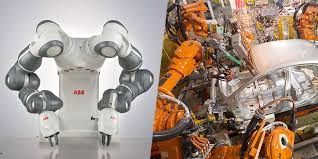The world of robotics is experiencing a revolutionary transformation, and at the forefront of this evolution are Collaborative Robots, or "cobots." These ingenious machines have quickly become a driving force in various industries, changing the way we work and perceive automation. In this article, we will delve into the fascinating world of cobots, exploring their history, applications, benefits, challenges, and the future they promise. Alibaba.com
Chapter 1: A Brief History of Cobots
Cobots, unlike their larger, industrial counterparts, are designed to work alongside humans in a shared workspace. The concept of collaborative robots was born in the late 1990s when researchers began exploring ways to make robots safer and more user-friendly. The early experiments and prototypes paved the way for the development of cobots as we know them today.
One of the pioneering companies in the cobot industry was Universal Robots, founded in Denmark in 2005. Their first cobot, the UR5, was introduced in 2008 and marked the beginning of a new era in robotics. Since then, many other companies have entered the cobot market, offering a wide range of collaborative robots designed for various industries and applications.
Chapter 2: Applications of Cobots
Cobots have found their place in a multitude of industries, bringing automation to tasks that were once considered too complex or dangerous for robots to handle alongside humans. Some of the most notable applications include:
- Manufacturing: Cobots are used in manufacturing plants for tasks such as assembly, pick-and-place operations, and quality control. They work seamlessly alongside human workers, increasing efficiency and precision.
- Healthcare: In the medical field, cobots assist surgeons in performing delicate procedures, automate repetitive tasks like medication dispensing, and even help rehabilitate patients through physical therapy exercises.
- Agriculture: Cobots are used for tasks like planting, harvesting, and weeding in the agricultural sector. They can work tirelessly, improving productivity and reducing the need for human labor in harsh conditions.
- Logistics and Warehousing: In e-commerce and logistics companies, cobots play a vital role in sorting, packing, and shipping products. They navigate warehouses autonomously, helping to fulfill orders quickly and accurately.
- Food Industry: Cobots are used in food processing and packaging, ensuring food safety and hygiene while handling delicate or perishable items.
- Construction: Construction sites benefit from cobots for tasks like bricklaying, concrete pouring, and demolition, improving safety and efficiency.
- Education: Cobots are also making their way into educational institutions, where they teach students about robotics and automation, fostering the next generation of engineers and technicians.
Chapter 3: The Advantages of Cobots
Cobots offer numerous advantages that make them an attractive choice for various industries:
- Safety: One of the most significant advantages of cobots is their ability to work safely alongside humans. They are equipped with advanced sensors and software that allow them to detect and react to human presence, minimizing the risk of accidents.
- Flexibility: Cobots are highly adaptable and can be easily reprogrammed to perform different tasks, making them a cost-effective solution for businesses with changing production needs.
- Efficiency: Cobots can work 24/7 without fatigue, leading to increased productivity and reduced production cycle times.
- Precision: Cobots are capable of performing tasks with high precision and repeatability, leading to improved product quality.
- Ergonomics: By handling repetitive and physically demanding tasks, cobots reduce the risk of workplace injuries and employee burnout.
- Cost-Effectiveness: Cobots are relatively affordable and have a quick return on investment, making them accessible to a wide range of businesses.
Chapter 4: Challenges and Limitations
While cobots Robots offer many benefits, they also face certain challenges and limitations:
- Cost of Implementation: While cobots are cost-effective in the long run, the initial investment can be significant, especially for small businesses.
- Programming Complexity: Programming cobots can be complex, requiring skilled technicians or engineers to set them up for specific tasks.
- Limited Payload and Speed: Cobots have limitations in terms of payload capacity and speed, making them unsuitable for some heavy-duty industrial tasks.
- Compatibility: Integrating cobots into existing systems and workflows can be challenging, requiring careful planning and adjustments.
- Ethical and Societal Concerns: As cobots become more prevalent, ethical concerns about job displacement and the impact on the workforce arise. It is crucial to address these concerns and ensure a smooth transition to a more automated future.
Chapter 5: The Future of Cobots
The future of cobots is bright and filled with exciting possibilities. As technology continues to advance, we can expect to see the following developments:
- Enhanced Capabilities: Cobots will become even more versatile, with improved sensors, AI-powered decision-making, and increased payload capacities.
- Increased Adoption: Cobots will find their way into more industries and applications, ranging from small businesses to large-scale manufacturing.
- Human-Cobot Collaboration: The collaboration between humans and cobots will become even more seamless, with improved safety features and intuitive interfaces.
- Education and Training: Educational programs will expand to prepare the workforce for the integration of cobots, ensuring a smooth transition and minimizing job displacement concerns.
Conclusion
Cobot robots have ushered in a new era of automation, revolutionizing industries and workplaces worldwide. Their ability to collaborate safely with humans, coupled with their flexibility and efficiency, makes them a valuable asset in various sectors. While challenges exist, the future of cobots promises continued growth and innovation, shaping a world where humans and robots work harmoniously together to achieve greater productivity and safety. As we embrace this collaborative future, it is essential to navigate the ethical and societal implications while reaping the benefits of this remarkable technological advancement. Visit official website qviro.com

